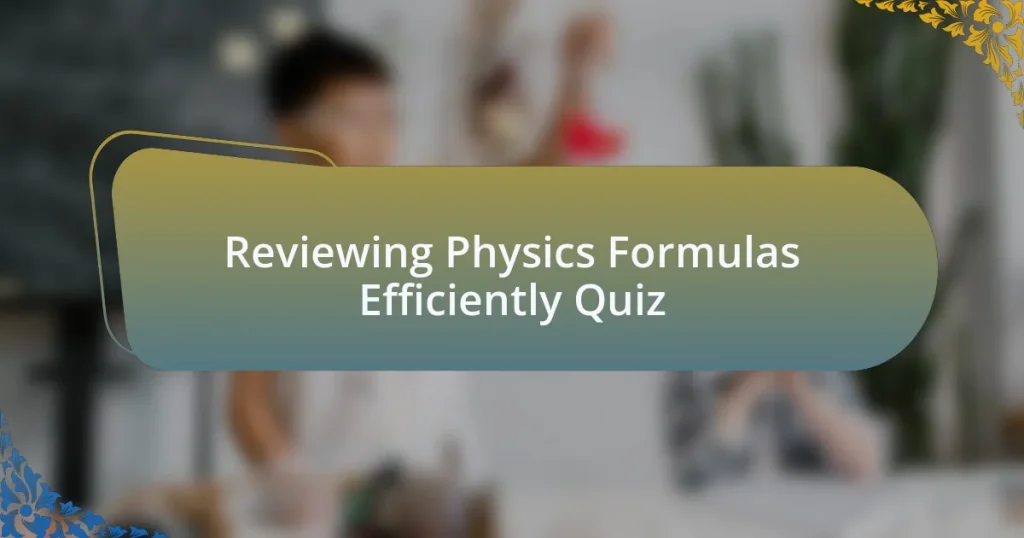Start of Reviewing Physics Formulas Efficiently Quiz
1. What is the formula for speed?
- Speed = distance / time.
- Speed = force / mass.
- Speed = time / distance.
- Speed = mass × acceleration.
2. What is the formula for force?
- Force = mass – acceleration.
- Force = mass + acceleration.
- Force = mass / acceleration.
- Force = mass × acceleration (F = ma).
3. What is the formula for acceleration?
- Acceleration = (v final – v initial) / time.
- Acceleration = energy / distance.
- Acceleration = velocity × time.
- Acceleration = mass / force.
4. What is the unit of acceleration?
- J
- N
- m/s²
- kg
5. What is the unit of force?
- Volts (V)
- Pascals (Pa)
- Newtons (N)
- Joules (J)
6. What is the unit of mass?
- Newtons (N)
- Grams (g)
- Kilograms (kg)
- Meters (m)
7. What is the unit of speed?
- Pounds per square inch (psi).
- Meters per second (m/s).
- Joules (J).
- Liters (L).
8. What is the formula for calculating average speed?
- Average speed = total distance / total time.
- Average speed = total time / total distance.
- Average speed = distance – time.
- Average speed = distance × time.
9. What are balanced forces?
- Unbalanced forces
- Balanced forces
- Frictional forces
- Gravitational forces
10. What are unbalanced forces?
- Unbalanced forces are always acting at rest.
- Unbalanced forces are equal in magnitude and opposite in direction.
- Unbalanced forces have no effect on motion.
- Unbalanced forces are forces that are not equal in magnitude and direction.
11. What is inertia?
- The speed at which an object travels in a straight line.
- The tendency of an object to resist changes in its motion.
- The force that acts on an object in motion.
- The energy an object possesses due to its position.
12. What is the formula for calculating acceleration from force and mass?
- Acceleration = force / mass (a = F/m).
- Acceleration = force + mass (a = F + m).
- Acceleration = mass / force (a = m/F).
- Acceleration = force – mass (a = F – m).
13. What is the term for the rate of change of velocity?
- Displacement
- Acceleration
- Momentum
- Velocity
14. What is the term for the rate of change of position?
- Speed
- Momentum
- Acceleration
- Velocity
15. What is kinetic friction?
- Kinetic friction is the force that increases with the speed of a stationary object.
- Kinetic friction is the force acting on objects with different masses in a vacuum.
- Kinetic friction is the force that opposes the motion of two surfaces sliding past each other.
- Kinetic friction is the force that holds an object in place when at rest.
16. What is static friction?
- Frictionless motion is the absence of any opposing forces between surfaces.
- Static friction is the force that prevents motion between two stationary surfaces in contact.
- Kinetic friction is the force that opposes motion between two surfaces in contact when they are stationary.
- Dynamic friction is the force that acts on moving objects only.
17. What is the formula for calculating distance with initial position and displacement?
- Distance = initial position / displacement.
- Distance = initial position – displacement.
- Distance = initial position + displacement.
- Distance = initial position × displacement.
18. What is power in relation to kinetic energy?
- Power is the force required to accelerate an object to a certain speed.
- Power is the square of velocity multiplied by mass.
- Power is the total amount of kinetic energy an object has.
- Power is the rate of change of kinetic energy with respect to time.
19. What is the formula for kinetic energy?
- Potential energy = mass × acceleration due to gravity × height (PE = mgh).
- Kinetic energy = 0.5 × mass × velocity² (KE = 0.5mv²).
- Force = mass × acceleration (F = ma).
- Work done = force × displacement (W = Fd).
20. What is kinetic energy?
- Kinetic energy is the energy stored in an object`s position.
- Kinetic energy is the potential energy of an object at rest.
- Kinetic energy is the energy required to break an object.
- Kinetic energy is the energy an object possesses due to its motion.
21. What is the formula for potential energy?
- Potential energy = mass ÷ height (PE = m/h).
- Potential energy = mass × velocity² (PE = mv²).
- Potential energy = force × distance (PE = Fd).
- Potential energy = mass × acceleration due to gravity × height (PE = mgh).
22. What is potential energy?
- Potential energy is the energy an object has due to its temperature.
- Potential energy is the energy stored in an object due to its position or configuration.
- Potential energy is the energy of motion an object possesses.
- Potential energy is the energy released when an object falls.
23. What is total energy?
- Total energy is only kinetic energy.
- Total energy is the energy of motion only.
- Total energy is zero in a closed system.
- Total energy is the sum of kinetic and potential energy.
24. What is the formula for work done?
- Work done = force × displacement (W = Fd).
- Work done = force / displacement (W = F / d).
- Work done = force – displacement (W = F – d).
- Work done = force + displacement (W = F + d).
25. What is work?
- Work is the energy an object has due to its motion.
- Work is the transfer of energy through force applied over a distance.
- Work is the force exerted on an object without movement.
- Work is the energy stored in an object due to its position.
26. What is the rate of doing work called?
- Work
- Force
- Energy
- Power
27. What is the formula for power?
- Power = work done / time taken (P = W/t).
- Power = mass × acceleration (P = ma).
- Power = energy × time (P = E/t).
- Power = force × distance (P = Fd).
28. What is energy?
- Energy is the speed of an object.
- Energy is the ability to do work.
- Energy is a measure of an object`s weight.
- Energy is the force applied to an object.
29. What is the change in kinetic energy called?
- Work
- Power
- Energy
- Force
30. What is the change in potential energy called?
- Change in kinetic energy
- Change in mechanical energy
- Change in potential energy
- Change in thermal energy
Congratulations on Completing the Quiz!
You’ve successfully navigated our quiz on reviewing physics formulas efficiently. This accomplishment not only showcases your dedication but also enhances your understanding of critical physics concepts. Whether you focused on vector calculations or learned about energy conservation, each question helps solidify your grasp of essential formulas.
Throughout the quiz, you likely picked up valuable strategies for memorizing and applying these formulas in various contexts. Understanding how to organize information effectively can make a significant difference in your test preparation. Moreover, practicing these formulas in a structured way can boost your confidence for future assessments.
We invite you to continue your learning journey by exploring the next section on this page, which delves deeper into the topic of “Reviewing Physics Formulas Efficiently.” It offers insights that can further refine your study techniques and help you master the material for your upcoming physics tests. Don’t miss out on the opportunity to expand your knowledge and elevate your performance!
Reviewing Physics Formulas Efficiently
Understanding the Basics of Physics Formulas
Physics formulas are mathematical equations that express relationships between physical quantities. They are essential tools for solving problems in mechanics, electricity, magnetism, thermodynamics, and more. For efficient review, it’s important to grasp the fundamental concepts behind each formula. Each formula typically represents a law or principle, such as Newton’s Laws of Motion or Ohm’s Law. Understanding these concepts helps in remembering the formulas and applying them accurately during tests.
Organizing Physics Formulas for Easy Access
Effective organization of physics formulas can enhance review efficiency. Group formulas by topic, such as kinematics, dynamics, and waves. This categorization allows for quick referencing and reinforces understanding of how formulas relate within each topic. Creating a formula sheet with sections for each area can streamline study sessions. Highlighting essential variables can also assist in memorization and application during exams.
Utilizing Mnemonics and Visual Aids for Retention
Mnemonics and visual aids can improve retention of physics formulas. Mnemonics are memory aids that simplify complex information into memorable phrases or acronyms. Visual aids, such as charts or diagrams, illustrate relationships and enhance comprehension. Pairing formulas with visual representations of the concepts can lead to better understanding and recall during tests. This method makes abstract concepts more tangible and easier to memorize.
Practice Applying Physics Formulas through Problem-Solving
Applying physics formulas through problem-solving reinforces understanding and retention. Practice a variety of problems that require the use of different formulas. This process helps to contextualize each formula and clarifies its application. Regularly solving problems under timed conditions can simulate test scenarios, boosting confidence. It also highlights areas where further review may be necessary, enhancing overall test preparation.
Timely Review and Reassessment of Physics Formulas
Regular review and reassessment of physics formulas are crucial for long-term retention. Implement a study schedule that revisits formulas over increasing intervals, known as spaced repetition. This technique encourages active recall, solidifying memory. Self-testing using flashcards or practice exams ensures formulas remain fresh in memory. Continuous engagement with the material leads to mastery and better performance on tests.
What are the key physics formulas to review for test preparation?
Key physics formulas include Newton’s laws of motion, which describe the relationship between forces and motion; the equations of motion for constant acceleration; the law of universal gravitation; and the equations of thermodynamics. These formulas are critical as they provide foundational knowledge for understanding various physics concepts and are frequently tested. Familiarity with these equations ensures stronger problem-solving skills in exams.
How can students organize their review of physics formulas?
Students can organize their review of physics formulas by categorizing them into topics such as mechanics, electromagnetism, and thermodynamics. Creating a formula sheet for each topic helps in easy access and quick revision. Furthermore, practicing problems that utilize these formulas reinforces understanding, making the review process more effective and targeted.
Where can students find reliable resources for reviewing physics formulas?
Students can find reliable resources for reviewing physics formulas in textbooks, online educational platforms such as Khan Academy or Coursera, and dedicated physics review websites like HyperPhysics. These resources offer comprehensive explanations, practice problems, and formula lists, catering specifically to physics test preparation.
When is the best time to start reviewing physics formulas for a test?
The best time to start reviewing physics formulas is at least four to six weeks before the test. This timeframe allows adequate opportunity for thorough review and practice. Starting early helps students identify weaker areas, enabling focused study sessions and reinforcing mastery of essential concepts.
Who can assist students in reviewing physics formulas effectively?
Teachers, tutors, and study groups can assist students in reviewing physics formulas effectively. Educators can provide structured guidance and clarify complex concepts. Tutoring offers personalized attention, while study groups facilitate collaborative learning, allowing students to share insights and resources to enhance their understanding.















